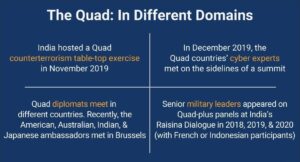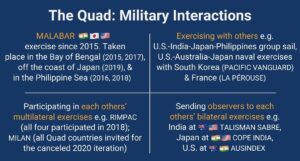Rise of China has become a major cause of concern for a rules-based order. All four QUAD nations find a common ground of being the democratic nations and common interests of unhindered maritime trade and security. And Beijing views the Quad as an attempt to contain its rise in Indo-Pacific region.
Static dimensions
- What is QUAD?
Current dimensions
- About the meeting and decisions taken
- Importance of QUAD
- Militarization of QUAD
- Its Shortcomings
Content:
About the meeting and decisions taken:
- Foreign ministers of all four Quad countries – US Secretary of State Mike Pompeo, Indian External Affairs Minister S Jaishankar, Australian Foreign Minister Marise Payne, Japanese Foreign Minister Toshimitsu Motegi attended the meeting held in Tokyo, Japan.
- This is the 2nd such Quad FMs meet.
- In 2019, all FMs of Quad countries had met on the sidelines of the UNGA.
- However this edition assumed significance, as it took place amid regional and global disarray on account of the COVID-19 pandemic.
- Discussion was regarding the post-COVID-19 international order and the need for a coordinated response to the various challenges emerging from the pandemic.
- Regional issues were discussed and all collectively affirmed the importance of maintaining a free, open and inclusive Indo-Pacific.
- It was stated that there were possibilities of new countries joining in future, especially fellow democracies in Europe like the U.K, France and Germany who are keen in upholding international law and norms of behavior in the South China Sea.
The differences which stood out include-
- Only the United States and Australia mentioned the need for the Quad to work toward countering disinformation.
- Australia’s statement alone mentioned the need for regional powers to conform to the United Nations Convention for the Law of the Sea.
- Japan explicitly named North Korea and the East and South China Seas as regional affairs that were discussed. Though the United States’ and Indian readout mentioned “regional issues of mutual interest”, Australia remained silent.
- India’s readout did not mention the need for the Quad to pursue cooperation around quality infrastructure.
- Japan’s statement alone noted the positive role of extra-regional powers (in its case, European countries) in maintaining a Free and Open Indo-Pacific.
- The Indian and Australian readouts explicitly mentioned cooperation around access to COVID-19 vaccines and Japan made an indirect reference for cooperation in the areas of health and hygiene but the US stood silent on this.
- India’s readout was the only one that omitted any reference to cybersecurity and data issues.
What is QUAD?
- The Quadrilateral Security Dialogue, also known as Quad, is an informal strategic forum between India, US, Japan, and Australia.
- The strategic alliance was formed to ensure peace and stability in the Indo-Pacific and check China’s expansionist efforts in the region.
- It was first mooted by Japanese Prime Minister Shinzo Abe in 2007 with the support of Vice President Dick Cheney of the US, Prime Minister John Howard of Australia and Prime Minister Manmohan Singh of India.
- The dialogue was paralleled by joint military exercises of an unprecedented scale, titledExercise Malabar.
- The first iteration of the Quad ceased to exist following the withdrawal of Australia in February 2008, after a joint naval exercise between the Quad and Singapore drew diplomatic protests from China.
- However, during the 2017 ASEAN Summits all four former members rejoined in negotiations to revive the quadrilateral alliance.
- The Quadrilateral met five times in 2017–2019.
- In March 2020, officials from the Quadrilateral met to discuss the COVID-19 pandemic and they were joined by New Zealand, South Korea and Vietnam for the first time.

Importance of QUAD:
India alone is not the victim of Beijing’s visible expansionism. China and Japan are at loggerheads over the Senkaku islands. Other ASEAN countries are quite literally on China’s radar on account of rival claims over maritime boundaries in the resource-rich South China Sea. After the COVID-19 outbreak, China’s relations with Australia have gone precipitously south. The regional turbulence in the Indo-Pacific has naturally drawn in the United States, which under the Trump administration has virtually declared a new Cold War with China.
Under these circumstances, the bonding of powerful democracies can change the economic and military balance of power vis-a-vis China. It aids in upholding a rules-based order and respect for international law in the strategically important region. It helps in creating a free, open, prosperous and inclusive Indo-Pacific region that serves the long-term interests of all countries in the region and of the world at large. Economically, the strategy is regarded as an answer to China’s Belt and Road Initiative (BRI), which is establishing a China-centric trade route.
Countering Chinese hard and soft power intrusions, especially through its BRI is expensive for India. To accomplish this herculean task against a formidable and implacable rival, India has to embrace the Indo-Pacific Quad. With India, located right at the centre of the Indo-Pacific geopolitical imagination, it can realize the vision of a ‘broader Asia’ that can extend its influence away from geographical boundaries.
Militarization of QUAD:
- Recently India’s Chief of Defense Staff (CDS) said that India has believed that the Quad would be a “good mechanism” to “ensure Freedom of Navigation Operations” (FONOPs) in the Indian Ocean and Indo-Pacific.
- The statement marks India’s approval to join Quad military patrols, which marks a departure from its earlier stance.
- The Indian Navy has not taken part in any joint patrols outside of the Indian Ocean.
- India has not yet formally announced a decision to include Australia in the annual Malabar exercises with the U.S. and Japan.
- But LAC tensions and clashes, as well as the China’s refusal to implement border agreements, have convinced India that new strategies would be required to deal with Beijing.

India is the only Quad member not already tied in a treaty alliance with the others. India also is the only country in the Quad that shares a land boundary with China and how the militarization of the Quad in Indo-Pacific waters would alleviate the territorial threat it faces is still unclear.
Shortcomings of QUAD:
- QUAD is neither institutionalized nor has a security framework.
- The ‘Quad’ has so far remained in the realm of strategic dialogues, white papers and occasional drills but not of a formal military alliance with a specific purpose like NATO during the Cold War era.
- To have the counter-impact on an expansionist China, a theatre of existence and critical posturing is required which QUAD lacks at present.
- The possibility of a Quad security architecture is far due to the varied interests of the nations involved and the presence of an already plentiful number of organizations in the region, like the ASEAN and the East Asia Summit.
- The entire focus on the Indo-Pacific makes the Quad a maritime, rather than a land-based grouping, raising questions whether the cooperation extends to the Asia-Pacific and Eurasian regions.
- How does QUAD underline the rising significance of maritime geopolitics in an increasingly integrated world.
Approach to the answer:
- Write why it is in news
- Write about its origin
- Write why it is necessary
- Conclusion














